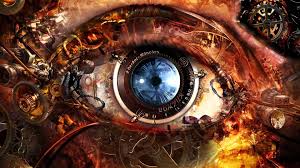The classical conception of the typical atom as being composed of a neat nucleus of indivisible protons and neutrons circled by electrons is largely passe, although for convenience sake we may still describe the atom that way. (In those terms, the one exception is the hydrogen atom, which evidently consist of but one proton and one electron cloud, or “smear.”) For the simple purposes of this blog, then, I’m leaving out considerations involving quantum mechanics, which concept repudiates the idea of “particles” to begin with. (And surely that notion involves more than a little of the psychic, or “irrational.” What a heretical thought from the scientific viewpoint!) But each atom of whatever element is an amazingly complicated, finely balanced assemblage of forces and particles woven together in exquisite detail — one of the more basic examples of the unending and stupendous creativity, order, and design of nature, or consciousness, or All That IS.
Through their work with particle accelerators, or “atom smashers,” physicists have discovered that protons and neutrons themselves are composed of forces and particles that in turn are almost certainly composed of forces and particles, and so on, in an ever-descending scale of smaller and smaller entities and concepts. Over 100 subatomic particles have been identified so far, and no one doubts now that many more will found. The existence of a number of still-undiscovered specific particles has been predicted.
Our scientists can count elements. That is, they will create more and discover more until they are ready to go out of their minds, because they will always create physical ‘camouflages’ of the real nonphysical thing. And while they create instruments to deal with smaller and smaller particles, they will actually see smaller and smaller particles, seemingly without end.
As their instruments reach farther into the universe they will ‘see’ farther and farther, but they will automatically transform what they apparently ‘see’ into the camouflage patterns with which they are familiar. They are and they will be the prisoners of their own tools.
Instruments calculated to measure the vibrations with which scientists are familiar will be designed and redesigned. All sorts finally of seemingly impossible phenomena will be discovered with these instruments, until the scientists realize that something is desperately wrong. The instruments will be planned to catch certain camouflages, and since they will be expertly thought out they will perform their function. I do not want to get too involved. However, by certain means the instruments themselves will transform data from terms that we cannot understand into.
Some of the “particles’ the theoretical physicists have discovered — and/or created — in their gigantic particle accelerators have unbelievably short life-spans in our terms, vanishing, it seems, almost before they’re born. I like to think of such research from the particle’s point of view, though, a consideration I haven’t seen mentioned in the few scientific journals I have read. The merest particle is basically conscious in its own way. Mesons are classes of particles produced from the collisions of protons. Did a meson, for example, choose to participate in an atom-smashing experiment in order to merely peek in on our gross physical reality for much less than the billionth of a second if exists with that identity, before it decays into electrons and photons? From its viewpoint, our reality might be an incomprehensible to it as its reality is to us — yet the two inevitably go together.
In it way the meson may have all of the “time” it needs, or wants. It may look upon our world as one frozen or motionless, upon other subatomic particles as very slow-moving indeed, or even faster than it is. (As far as “time” goes, some particles live for far less than a trillionth of a second.”) I’m quite sure, however, that the meson, or any short-lived particle, searches out its own kind of value fulfillment while here with us. Probable realities, which I haven’t even mentioned, must be deeply involved also.
And of course there are all sorts of motion, some of them very stable, if still incomprehensible to us. But whereas the meson vanishes from our view after its exceedingly brief existence, the electron has an “infinite” life-span. Think of the unending varieties of value fulfillment it explores in just our world alone! Talk about motion: The average electron orbits its atomic nucleus about a million times each billionth of a second (or nanosecond).
Electromagnetic energy units (or units of consciousness), these nonphysical entities — and many others of a like nature — are emanations of consciousness, or All That Is, and in “size” rank far below the tiniest particles ever observed in atom smasher. Each unit of consciousness contains within itself innately infinitely infinite properties of expansion, development and organization; yet within itself always maintains the kernel of its own individuality. It is aware energy, not personified but awarized.
The varieties of consciousness — the inner psychological particles, the equivalent, say, of the atom or molecule, or proton, neutron or quark — those nonphysical, ‘charmed,’ ‘strange,’ forms of consciousness that make experience go up or down, and all around and around — are never of course dealt with by science.
If physical form is made up of such multitudinous, invisible particles, how much more highly organized must be the inner components of consciousness, without whose perceptions matter itself would be meaningless. The alliances of consciousness, then, are far more vast than those of particles in any form.






